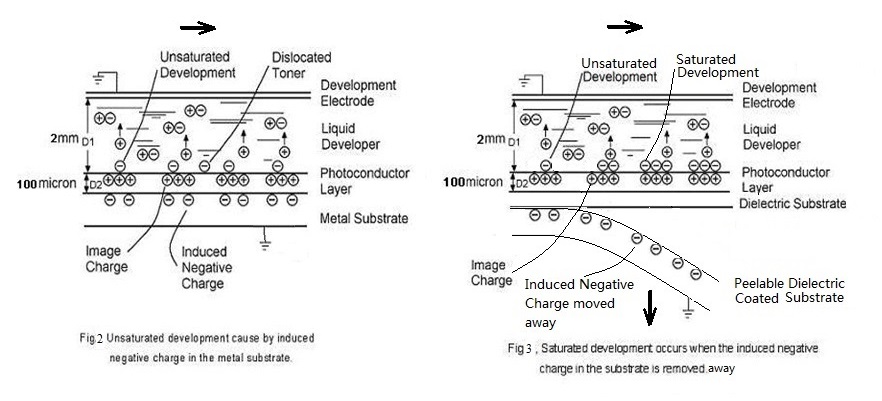
[PREVIOUS]
[NEXT]
[HOME]
My invention of a high density laser recording tape

Fig.2 is the operation principle of the xerographic laser printing system. The cause of the low resolution in the xerographic process is that the positive image charge on the photoconductor surface is balanced by an induced negative charge in the grounded metal substrate. The electric field inside the image development area is inversely proportional to the distance from the photoconductor surface to the development electrode (D1) and the distance from the photoconductor surface to the metal substrate (D2). Because D1 is normally 2mm and is D2 is normally 100 micron, 95% of the electric line of force will be inside the photoconductor, leaving only 5% of the electric force for development. This makes the image charge difficult to attract and hold the negatively charged toner particles, as a result the charge latent image is only partially developed and developed particles are easily dislocated. Therefore, the developed image suffers from low resolution and subsequently low quality.
My invention will overcome this drawback by removing the induced negative charge in the replaced peelable dielectric coated substrate, Fig.3. Now 100% of the electric force of the image charge can be used for development, the positive image charge can attract the negative toner particles till saturation. I do not want to go in detail of the process of the system. The description of the process can be found in U.S. patent office patent number 4,756,992. Actually we do not need to bother how the process is. We just need to make a logical deduction what resolution can be achieved when there is no induced negative charge in the replaced dielectric substrate. My deduction is that the resolution will be so high that it is only be limited by the size of the writing blue laser beam, because even atoms are made of positive and negative charges. The attraction force between the charge latent image and the developed toner particles will be so strong that the turbulence in the liquid development area will not cause dislocation of the toner particles. In the way very high resolution and higher printing speed can be achieved. This process has more extra steps than conventional the xerographic process. But if you can see the high resolution this process can achieve, the extra steps are worth while.
I believe my invention is most suitable in making a high density laser data recording tape. A tape can has much more recording area than a disc. It can even be applied to digital printing after proper development. Digital printing directly from computer with a printing quality as good as offset printing. I submitted my invention to many big companies. Unfortunately no one is interested, even my former employer Xerox. Actually I was confused by Xerox scientists's evaluation that a stronger electric would not produce a higher resolution image. I keep on asking to carry out an experiment to validate my idea but Xerox scientists were not willing to do so. This invention has a very big market as we need to record large amount of data daily. I believe the reason why people rejected my invention is because scientists cannot see the possibility that my idea will work, just like people could not see, at first, the Wright brothers’ wing shape of curved on the upper surface and flat on the lower surface could produce lift. I keep on asking other scientists to carry out an experiment to verify if my idea will work, but nobody is willing. The Wright brothers wing shape had a possibility that it could produce lift. But nobody could be sure before an experiment. Similarily nobody can tell if my invention will work or not without an experiment. As to my other invention, I need to file a patent application before showing to anybody.
Reader, if you have any question or comment, write to
Stephen Cheng